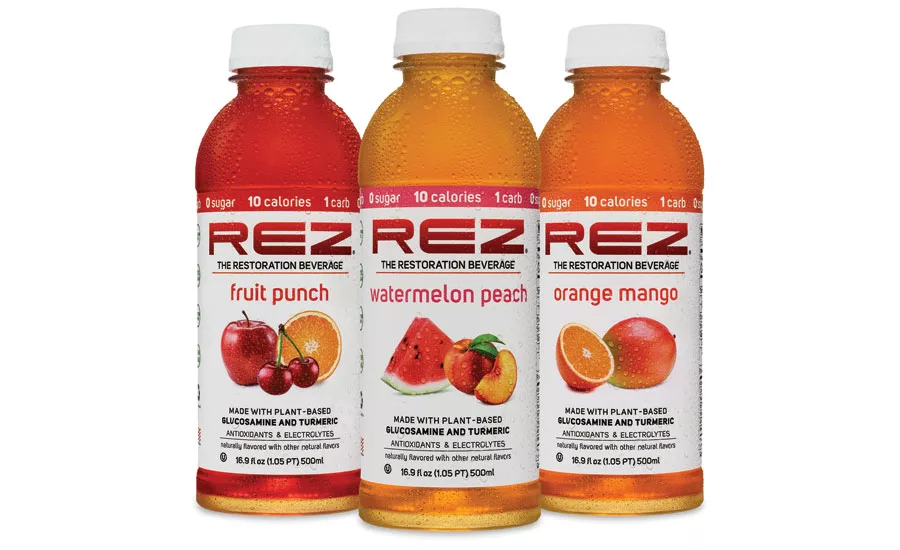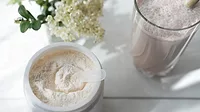Antioxidants deliver health attributes in convenient form
Dark berries, fruits and extracts popular sources for antioxidants in beverages

In the episode titled “Desert Island Dish” on the PBS TV show “Arthur,” the students are asked by their teacher to imagine themselves stranded on a desert island where they can bring an unlimited supply of one food item. The teachers asks them to pick an item and explain why they chose it. After nixing the junk food options, many students decide on various healthier options like plain oatmeal, brussels sprouts and eggs. However, one student continues to be perplexed that none of these options on their own would provide all nutrients that one needs. After a nightmare about trying to find the “perfect” food, the student convinces the other friends to collectively discuss what each food product provides when consumed together, thereby impressing the teacher with their educated analysis.
Today’s consumers might not have a quirky teacher who is encouraging them to analyze their food and beverage habits, but many are rethinking their choices of yesteryear and turning to solutions that will offer a more balanced diet.
“We see a large-scale shift taking place as consumers become more aware of making health-conscious choices,” says Andrew Wheeler, vice president of corporate marketing for FutureCeuticals, Momence, Ill. “No longer seen as a fad, the modern consumer wants ‘wellness’ to be infused in every part of their lifestyle, from their functional foods to their workouts to their mental health. However, they also demand convenience as their lives continue to become busier and busier.”
One of the ways in which consumers are finding a way to incorporate healthy convenience is through the use of antioxidants.
“Antioxidant ingredients deliver convenience without compromise,” Wheeler says. Noting that antioxidants ideal to use in ready-to-drink (RTD) beverages, Wheelers explains that "shoppers are inclined to buy products with antioxidant claims that help them recover from oxidative stress caused by exercise, their environment, and even the foods that they eat.”
Vaughn DuBow, brand manager for MitoCarn, a division of Covington, La.-based Alfasigma, details that antioxidants’ use spans many different demographics.
“Consumers of all ages have looked to antioxidants for their ability to defend cells from damage caused by harmful free radicals,” DuBow explains. “When free radicals accumulate, they can cause oxidative stress within the body, which can in turn increase the risk of specific types of disease. Consuming beverages with antioxidants can have a beneficial effect in helping to neutralize free radicals. This has drawn the attention of consumers and manufacturers alike in seeking antioxidant-rich beverages beyond naturally occurring ones such as coffee or green tea.”
Charlotte Mostaed, director of marketing at The Wonderful Co., Los Angeles, echoes similar sentiments: “We are seeing consumers look for smarter drink choices, as well as healthier options and ways to incorporate foods that positively affect their overall well-being,” she says. “They are increasingly looking for clear benefits from their beverages and turning toward clear-label products where the ingredients are simple and come from natural sources.”
FutureCeuticals’ Wheeler also highlights the impact that clean-label trends are having on the growth of antioxidants.
“The usage of antioxidant ingredients is also influenced by the clean-label movement,” he says. “Amongst RTD beverages, claims aligned with the ‘clean’ trend are the most prevalent and we can continue to expect growth in that area in the future. Consumers are taking a stand against added sugars and unfamiliar ingredients. Instead, they opt for clean-label transparency. Antioxidant ingredients offer ideal clean-label compliance because they are recognizable and have well-known benefits.”
Rikka Cornelia, product manager at BI Nutraceuticals, Rancho Dominguez, Calif., notes that clean-label trends has allowed some antioxidant sources to expand their usage base. “The clean-label trend, which has proliferated the use of natural alternatives, has also influenced the use of antioxidant ingredients,” Cornelia says. “Certain antioxidants, such as rosemary extract, can be added to beverages to preserve the shelf life and prevent off-flavors from developing. In other instances, antioxidants can be used as a natural colorant, such as red berries.”
More and more consumers also recognize the value of antioxidants.
“We also know that antioxidants are a key purchase driver, on par with protein and calorie count when people are buying any food or beverage,” The Wonderful Co.’s Mostaed says. “In fact, half of consumers surveyed cited antioxidants as somewhat or very important when making these purchases.”
This importance is ever-present in the super-premium juice segment, she notes. “Antioxidants are even more important when buying a super-premium juice beverage, landing amongst the top four things considered when making a purchase, with 66 percent of shoppers saying antioxidants are somewhat or very important,” Mostaed says.
Capitalizing on the benefits
Given the health benefits associated with antioxidants, beverage-makers are making concerted efforts to incorporate ingredients that deliver the free-radical-fighting power they possess. Yet, as brand owners look for solutions, they have an abundance of options from which to choose.
“Berries are loaded with the flavonoids that bring antioxidant identity and appealing flavor profiles to beverages that feature familiar and exotic berries touting those benefits,” says John Sauve, vice president of marketing for Artemis International, Fort Wayne, Ind. “Beverage companies looking to capitalize on the perceived health benefits associated with antioxidants look to berries and berry ingredients to build their new products and their marketing messages. The branding and innovative positioning of beverages with the promise of antioxidant power and great taste from berries is limitless.”
Sauve explains notes that dark-colored berries can fulfill this objective as consumers already associate these ingredients with antioxidant content.
“Dark berry-based ingredients play a key role in beverages for delivering and supporting an antioxidant marketing message to consumers,” he says. “An example lies in the long established antioxidant properties and benefits associated with blueberries, in any form. A relative newcomer to the antioxidant berry playing field is aronia, which has demonstrated its top player talents in the antioxidant, anthocyanin and proanthocyanidin game.”
As part of its portfolio, Artemis offers Berryceuticals, extracts from a range of dark berries that deliver a high level of antioxidant properties, Sauve says.
“The existing and always-growing positive perceptions of dark berries and their antioxidant characteristics give our branded Berryceutical extracts like ElderCraft, AroniaCraft and CurrantCraft an awareness and interest boost — always a marketing benefit,” he says.
Harkening back to the influence of clean label, BI Nutraceuticals’ Cornelia expands on the sources that beverage-makers are turning to when looking to add antioxidants.
“The trend of clean label is influencing all food and beverage segments, including antioxidant-rich beverages,” Cornelia says. “We are starting to witness more individuals seeking ingredients with naturally occurring antioxidants, such as acerola with naturally occurring vitamin C or green tea with naturally occurring polyphenols. However, its influence is not as entrenched as it is in other segments. While consumers are demanding the complete removal of ‘overly’ processed/‘chemically sounding’ ingredients in other product applications, isolated nutrients like astaxanthin, beta-carotene and curcumin remain very popular antioxidant ingredients.”
For beverage formulations, FutureCeuticals’ Wheeler touts the benefits of working with extracts when sourcing antioxidant sources.
“Popular antioxidant sources that work well in beverage applications include fruit and vegetable extracts that are natural sources of proanthocyanins, quercetin, polyphenols, and phytonutrients,” he says. “These antioxidants can offer solubility and low dosage, which is ideal for functional RTD beverages.”
MitoCarn’s DuBow also lists apples, tomatoes, pink grapefruit and pomegranate as ingredient options that deliver high antioxidant content. He also pinpoints the benefits of utilizing the amino acid L-carnitine for health and wellness.
“L-carnitine can also be used in beverages and absorbed quickly by the body,” DuBow says. “While L-carnitine is naturally produced in the body by the liver and kidneys, supplementation is important for providing the body with beneficial levels.”
Antioxidants are crucial to the branding of The Wonderful Co., and are critical to building the legacy of its POM Wonderful brand by delivering antioxidants from its Wonderful variety California-grown pomegranates.
“We go to [great] lengths to get the most from every piece of fruit so that our consumers are getting the entire polyphenol-rich package that comes from the pomegranate, the original superfruit,” Mostaed says. “Pomegranates are a source of flavonoids, punicalagins, ellagitannins and anthocyanins.”
First-class education
Although the benefits surrounding antioxidants are more understood today than in years past, suppliers and brand owners are committed to making sure there’s no confusion and that consumers understand the enriching health benefits of the ingredient.
“To continue investing in growing the super-premium juice (SPJ) category, POM Wonderful is launching a brand-new marketing campaign focused on communicating the health benefits of antioxidants and reinforcing POM Wonderful 100% Pomegranate Juice as the antioxidant superpower,” Mostaed says. “The creative advertisements provide insights and awareness around antioxidants by displaying the iconic POM bottle in compelling designs that bring the potent health benefits of antioxidants to life.”
FutureCeuticals’ Wheeler adds that educating consumers about the benefits of antioxidants has evolved beyond buzzwords to include evidence to support such claims.
“Consumers are educating themselves about their food and beverage purchases now more than ever,” he says. “If a product simply advertises containing antioxidants, skeptical shoppers might reconsider their purchase. The future of antioxidant innovation lies in substantiated antioxidant serving claims.
“Our ingredient, PhytoServ, is a proprietary line of powdered, plant-based extracts that make it possible to deliver substantiated serving claims from the powerful phytonutrients found within fruits and vegetables,” Wheeler continues. “Our exclusive method of substantiation connects the essential phytonutrients concentrated in our extracts to the equivalent found within one serving of fresh fruit or vegetables, gaining the approval of skeptics. PhytoServ is ideal for applications that require low dose or full ingredient solubility, like beverages.” BI
Looking for a reprint of this article?
From high-res PDFs to custom plaques, order your copy today!






